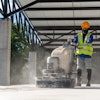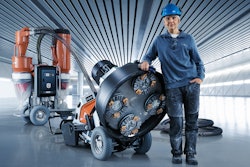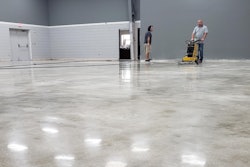
When working on any surface preparation job, rental companies want to help contractors make the most of every moment on the jobsite so that they can meet both the deadline and the client’s expectations. If that contractor arrives on site to grind a floor and learns that the concrete is covered, the machine doesn’t work, or it does and it damages the floor, it can be frustrating. Machine downtime can increase costs for the contractor and increase the risk of missing deadlines. The more rental companies can do to prepare their machines before they arrive on site, the better.
While many flooring covering options are long lasting, in some applications, the most durable, cost-effective and aesthetic flooring option can be the concrete substrate itself. Concrete floors are now a popular choice in a range of applications, including parking structures, warehouses, commercial facilities and residential basements. Turning concrete from a substrate intended to be covered into an appealing floor requires one to grind and polish the material to flatten, smooth and remove any imperfections. When working on a polished concrete floor contractors must take extra care. Any mistakes will be visible in the final floor.
Find out how rental companies can ensure their contractor customers get the most out of their grinding equipment and deliver a polished concrete floor on time and to a client’s expectations?
Choose the right tooling
One of the most common reasons equipment isn’t delivering the expected results is that the contractor has not selected the right tooling. Every surface preparation job is different, so before starting any work, contractors should visit the site to understand what is already adhered to the concrete, the current state of the material and the desired finish. From there, the rental company should ask questions of the contractor to help them choose the appropriate equipment. These will help determine the steps and tooling required to complete them. For example, there may be adhesives or coatings that require contractors to scrape the floor before grinding.
The desired finish will determine the concrete surface profile (CSP) required. If the floor requires a coating, contractors may need to prepare the substrate to a higher CSP so the covering will adhere.
Don’t get aggressive
No matter the required result, when grinding a floor, rental companies should advise contractors to use less aggressive tooling and work their way up. Starting off with a more aggressive tool to remove any bumps or thin coatings may speed up removal, but it may also damage the concrete, making it more difficult to deliver an appealing polished floor to the client. Alternatively, it’ll take time and money to fix the mistake.
Carbide chips, for example, can remove paint or left over adhesive from previous coverings, by scraping the concrete without digging into the material. Then, contractors can start using polycrystalline diamonds or other diamond tools. Starting with diamonds with a lower grit, which are less aggressive, contractors can keep increasing the grit of the tool until they reach the required result. These diamonds come in three main forms: soft, medium, and hard. To match the matrix, contractors should use soft bonded diamonds on hard concrete and hard bonded diamonds on softer concrete. This ensures that contractors expose the diamonds on the tool at the correct rate to deliver the required CSP.
Troubleshooting
If the floor is properly prepared for grinding and polishing, the tools are right for the application, but contractors still aren’t seeing the results they expect, rental companies can suggest other steps to make the most of the grinder.
Adjust the speed to the requirements of the job. For example, if a contractor needs to remove adhesive, he or she should grind at a lower speed, because higher speeds create friction and require higher force on the machine. The more friction there is, the more heat is generated, increasing the risk that the adhesive on the floor will melt and become difficult to remove. Contractors can even add ice to the floor and wet grind to make this easier.
When polishing concrete using diamonds, increasing speed adds weight to a machine and creates the friction needed to ensure the tooling stays in contact with the concrete, delivering a cleaner profile. If the tool isn’t aggressive enough, contractors can also add attachable weights to their machine. Taking time to find the sweet spot ensures contractors are working efficiently but not so fast that they skip over some of the material.
Machine issues can also cause issues or downtime once on site, so regular maintenance is key. Rental companies should be sure to clean the underside of a grinder after any job to help keep dust from one site negatively impacting the next. Rental companies can also look at the state of specific tooling on the machine before renting it out. This may look different depending on the machine in use. Keeping instructions on fixing the belt and necessary tools for maintenance on site will make it easier to get the machine back up and running.
Delivering projects on time and to specification helps contractors build trust with customers and confidently pitch for larger projects. Taking the time to prepare the right machinery and tooling before the work begins and knowing how to efficiently complete the work while still delivering quality can help rental companies' contractor customers maintain uptime and reduce the risk of costly mistakes.
![Tom Griffin 647ddaf100d60[1] Headshot](https://img.forconstructionpros.com/files/base/acbm/fcp/image/2023/10/Tom_Griffin.647ddaf100d60_1_.6537d4d7bb8da.png?auto=format%2Ccompress&crop=faces&fit=crop&h=48&q=70&w=48)



















